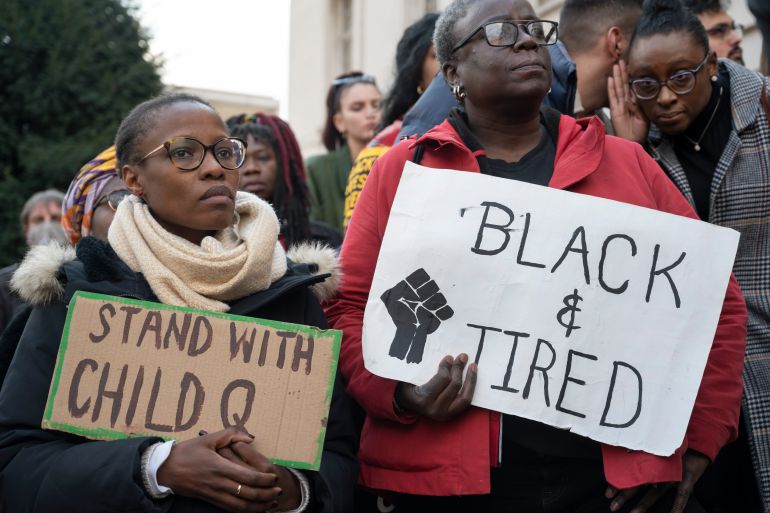The abuse of Child Q should make Britain rethink its drugs laws
The intersection of racist policing and harmful drug laws led to the shameful treatment of the 15-year-old schoolgirl.

In March 2022, the revelation that a 15-year-old Black pupil had been strip-searched by police in a London school after being wrongly accused of having drugs in her possession sent shockwaves across the United Kingdom – and for good reason.
Everything about the 2020 incident is absolutely harrowing. An independent child safeguarding report found that her own teachers called the police on the young girl after suspecting she may be carrying cannabis. Once they arrived at the school, Metropolitan police officers took the girl into a medical room and strip-searched her without appropriate supervision, despite being aware that she was menstruating. After the invasive and traumatising search, she was asked to “go back into the exam” she had been sitting, with no teacher asking about her welfare.
Keep reading
list of 4 itemsBehind India’s Manipur conflict: A tale of drugs, armed groups and politics
Why are some countries decriminalising drugs?
Tonnes of cocaine seized after high-speed boat chase in Colombia
The safeguarding report concluded that the treatment of the child was unjustified and racism was “likely” a reason why she was strip-searched in the first place.
While the trauma inflicted on Child Q understandably shocked the nation, the actions of the police in this case can hardly be considered an anomaly. It is well known that communities of colour are disproportionally policed in the UK, and British police commonly respond to alleged drug offences – especially when the suspect is a person of colour – with violence.
But racism was not the only reason why this child was subjected to a traumatic strip-search in her own school. When considering the factors that led to the shameful treatment of Child Q, there is also a need to look into the intersection of institutional racism in the police force, and our country’s drug laws.
Indeed, our drug laws are significantly increasing the possibility of children of colour having contact with the criminal justice system, and indirectly facilitating situations where police abuses of power can occur. The prohibition of drug possession has, in practice, given law enforcement a blank cheque to systematically target and criminalise communities of colour.
The racist bias in drug searches is blatantly clear in the data. As an organisation advocating for policy reform and drug decriminalisation, Release has highlighted how Black and other minority ethnic communities have been disproportionately impacted by our current drug laws, which prohibit the possession of cannabis and any other drugs controlled under the Misuse of Drugs Act 1971.
Drug policing, including via strip-searches, has particularly targeted people of colour: Black people are stopped and searched for drugs at almost nine times the rate of white people, despite the “find” rate being lower for Black people.
As one of the most invasive forms of searches, strip-searches are used surprisingly often on children, and almost always for drug possession. In Hackney, the London borough where Child Q was strip-searched, for example, 25 other children had been strip-searched in 2020/21, of which only two were white. Of those 25 searches, 80 percent had been for drugs. In 22 of those 25 searches, no drugs were found.
In each of these cases, police officers thoroughly searched the clothes and possessions of a child, determined they were not carrying drugs or other unlawful items, but still proceeded to conduct a strip-search – they felt the need to strip a minor naked to prove that they were indeed not hiding anything in their body. The racial disparity in child strip-searches is a reflection of Black children being denied the presumption of innocence readily offered to their white counterparts. It demonstrates that Black minors are commonly viewed as a potential threat to public safety.
Moralising arguments that drug prohibition is needed to safeguard children do not hold up in practice, as the case of Child Q clearly shows. Drug policy is actually exacerbating harm. The dogged pursuit of eliminating all drug use is enabling police to criminalise and traumatise children.
This is why Release advocates for non-punitive approaches to drug policy. Indeed, we do not need to look far for safer and less violent alternatives to the current punitive model of drug control in the UK.
Over 30 countries and 50 jurisdictions across the world have moved towards the decriminalisation of drugs, or the removal of criminal sanctions for possession. Of course, there are vastly different models for decriminalisation, and some work better than others to reduce harm, particularly those that pair legal reform with harm reduction initiatives and other forms of support for those who wish to access it. But importantly, decriminalisation can be purposefully designed to ensure that police officers are not allowed to deploy callous and traumatising tactics in schools.
There is much work that needs to be done to ensure no other child in the UK ever faces the injustice faced by Child Q. Institutional racism and the harms caused by racist policing are not going to disappear overnight. Until major changes are made to the role of police in public safety, there will continue to be a traumatised child for every letter of the alphabet suffering a similar fate as Child Q.
Drug policy reform, of course, cannot address police violence or end systemic racism on its own. But it can without a doubt reduce the amount of contact communities of colour – and especially children – have with the criminal justice system. Reforming the UK’s drug policies can be a key step in the long journey towards addressing state violence and changing the way policing occurs in society for the better.
The views expressed in this article are the author’s own and do not necessarily reflect Al Jazeera’s editorial stance.